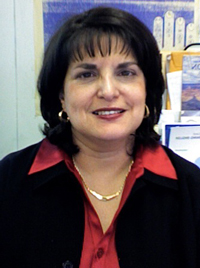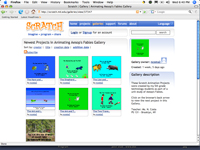Nancy M. Costa
ncosta2@schools.nyc.gov
PS 131
4305 Ft. Hamilton Pkwy
Brooklyn, N.Y. 11219
Grade & Subject Areas: Elementary + ELA / Instructional Technology
| About the Grant: |
Materials:
Computers with Internet access, copies of Aesop's fables.
Suggested Reference Paperbacks:
Aesop's Fables Retold by Ann McGovern
Published by Scholastic Copyright 2001, ISBN: 0-590-43880-8;
The Aesop for Children
With Pictures by Milo Winter
Published by Scholastic 1994,
ISBN: 0-590-47977-6;
Aesop's Fables Online
- Various websites - links provided below.
- Scratch Software - (Open Source) - free download from scratch.mit.edu website; Project Storyboard pages 1 & 2
- Scratch Getting Started Guide
- Scratch Reference Guide
- Project Storyboard rubric
- Scratch Animation Project rubric
Project Description:
The learning objectives for this project are two-fold. Using a variety of print and online resources, students will study the "fable" genre, with specific
focus on Aesop's Fables. They will learn that a fable is a short story that teaches a lesson or moral. The second goal of this project is for students to develop
technology skills in graphic programming which they will use to produce simple animations of their fables.
As part of a study of Aesop's Fables, the students will create animations of their favorite fable. Collaborating with a partner, each team will read and create a script
for their fable using a storyboard. Once their storyboard is completed, the students will transform their scripts into interactive, animated stories, using Scratch, a free (open-source)
graphic programming software created at the MIT Media Lab. Incorporating graphics, selected background scenes, recorded sound and/or music clips, and student-created
animation blocks, the students will bring their fables to life.
How it Works:
The students are first introduced to the fable genre. Initial class lessons focus on the characteristics of this short story genre and how these features are the same and/or different
from other genres studied, such as fairy tales or tall tales. Students are assigned several of Aesop's fables to read and analyze. They share their fable with their
classmates and the students will guess what the moral or lesson of the fable is. Students are divided into teams of two members each. Each team will select a fable that they will animate using the Scratch programming software. Lessons on how to use the
Scratch software will follow. Suggested activities are provided on the MIT support webpage located at http://info.scratch.mit.edu/Support. A
Reference Guide and Getting Started Guide are provided for download free of charge.
Following these lessons on Scratch, each team will develop a storyboard plan for animating their fable. Included in their storyboard script, they will decide what images, backgrounds,
dialog, music, and props are needed to create a realistic animation of their fable. They will also plan which animation blocks they need to create in order to make their stories
come to life.
Two assessment rubrics have been included in this lesson plan to assist teachers and students in assessing the preparation work they have completed on the storyboard as
well as completion of the final animation product.
|
| How This Grant was Adapted: |
Overall Value:
Today's students must master important learning skills in order to be prepared for the 21st Century. These learning skills are critical for their future success. According
to the Scratch software developers, 21st Century students ".must learn to think creatively, communicate clearly, analyze systemically, use technology
fluently, collaborate effectively, design interactively, and learn continuously." By integrating the use of a programming software like Scratch into a typical
genre study of fables, teachers will be taking the student's learning to a higher level - a level in which these critical 21st Century skills are addressed.
Tips for the Teacher:
As a result of the video game explosion of recent years, children as young as kindergartners are using technology on a regular basis. Thus, today's students naturally gravitate
to the use of technology in the classroom. By introducing them to Scratch animation, you will be tapping into a talent and interest many of them already have. Having your
students participate in this program will encourage them to think critically and creatively, and they will also learn to collaborate with others to create a final product. Your
students will be engaged in their learning and have fun at the same time!
The most interesting and possibly challenging piece of implementing this project will be teaching the students how to use the Scratch software. The Scratch website Support Webpage offers
excellent reference material and 12 "practice" Scratch activity cards. I strongly recommend that the teacher introduce each of these activity cards to the
students first, with each activity saved by the students upon completion. This will give them a clear understanding of how to create Scratch "code" by putting together various animation
blocks. They will then be able to transfer these learned skills to their own design and creation.
Following the publishing of the student projects to the MIT Media Lab server, the projects may be shared with other students and classes around the school. This adds another valuable
resource available to teachers teaching their students the "fable" genre. |
| Project URL |
After each team created their fable animation (final product), I uploaded the students' work to my Scratch account on the MIT server. (Anyone age 13 and older
may create a free account on the MIT Scratch server ). Click on this link to view the project in the "Animating Aesop's Fables Gallery" that
I set up on the MIT server. The individual student projects can be downloaded by others in order to examine the code created to animate the fable.
Project URL: http://scratch.mit.edu/galleries/view/37347
Special Note: Participating teachers who wish to add their student's work to my gallery may contact me at ncosta2@schools.nyc.gov and
request permission to upload their projects to the "Animating Aesop's Fables Gallery". This would be an excellent way to foster communication, collaboration, and learning
between teachers and students from different schools.
|
| Objectives |
Objective 1:
Students will identify the important features and elements that are characteristic of the fable genre.
Objective 2: Students will identify and explain the moral or lesson associated with a particular fable and how it relates to human behavior.
Objective 3:
Students will analyze, interpret, and create a personal script depicting a selected fable and its lesson or moral.
Objective 4:
Students will collaborate effectively with another teammate to produce a storyboard plan and an animated interactive version of a selected fable of their choice.
Objective 5: Students will read aloud expressively to convey a clear interpretation of the work.
Objective 6:
Using the Scratch software, the students will create simple Scratch animations by snapping together graphic blocks and creating a script for animation.
Objective 7:
Students will create their own animated interactive version of a selected fable, including graphics, background images, recorded sound/music clips, and animated graphic blocks.
|
| Websites Used |
Link 1: http://scratch.mit.edu
Description: Click on this link to download the (Open Source) Scratch programming software (free of charge) from this MIT Media Lab website.
Link 2: http://info.scratch.mit.edu/Support
Description: This onsite support page supplies the teacher and students all they need to learn how to use the Scratch software, including Intro videos, a Getting Started
Guide, A Reference Guide, and 12 Scratch Cards. The Scratch cards provide a quick way to learn new Scratch code. The front of the card shows what you can do; the back
shows how to do it.
Link 3: http://mags.acm.org/interactions/20080304/?pg=52
Description: Excellent
online reference article for teachers: "Empowering Kids to Create and Share Programmable Media".
Link 4: http://umass.edu/aesop/index.php
Description: This University of Massachusetts (at Amherst) website is an excellent resource site for student-friendly retold versions of Aesop's Fables.
Link 5: http://tinyurl.com/baldwinproject
Description: The Baldwin Project - Bringing Yesterday's Classics to Today's Children - This website provides an excellent collection
of updated versions of Aesop'e Fables.
Link 6: http://aesopfables.com/
Description: This website hosta an online collection of Aesop's Fables, including a total of 655+ Fables, indexed in table format, with morals listed.
Link 7: http://mcwdn.org/fables/aesop.html
Description: This literacy site introduces students to some of Aesop's fables with vocabulary review, quizzes, thought questions and activities.
Link 8: http://mcwdn.org/fables/fabplay.html
Description: This links to an online fable script form the student teams may use to plan out their fable script.
|
| Standards Addressed: |
Standard 1: ELA
Identify literary elements, such as setting, plot, and character, of different genres.
Grade: Elementary - Grade 5
Subject: Listening and Reading
Standard 2: ELA
Present information clearly in a variety of oral and written forms such as summaries, paraphrases, brief reports, stories, posters, and charts
Grade: Elementary - Grade 5
Subject: Speaking and Writing
Standard 3: ELA
Recognize some features that distinguish the genres and use those features to aid comprehension.
Grade: Elementary - Grade 5
Subject: Listening and Reading
Standard 4: ELA
Use inference and deduction to understand the text
Grade: Elementary - Grade 5
Subject: Listening and Reading
Standard 5: ELA
Monitor and adjust their own oral and written presentations to meet criteria for competent performance
Grade: Elementary
Subject: Speaking and Writing
Standard 6: ELA
Identify essential details for notetaking
Grade: Elementary - Grade 5
Subject: Reading and Writing
Standard 7: Math-Science-Technology
Control computerized devices and systems through programming
Grade: Elementary
Subject: Computer Technology
Standard 8: Math-Science-Technology
Participate in small group projects and in structured group tasks requiring planning, financing, production, quality control, and follow-up.
Grade: Elementary
Subject: Management of Technology
Standard 9: Math-Science-Technology
Model and simulate the design of a complex environment by giving direct commands
Grade: Elementary
Subject: Computer Technology
Standard 10: Math-Science-Technology
Use the computer as a tool for generating and drawing ideas
Grade: Elementary
Subject: Computer Technology
|
| Lesson 1: |
Special Note:
This is the link to the online project: http://scratch.mit.edu/galleries/view/37347
If anyone should need further assistance or suggestions on how best to implement this project, please do not hesitate to contact me at the email address provided above. |
|

Nancy Costa has been an elementary school teacher for the NYC Dept. of Education for 32 years. She currently serves as P.S. 131's Instructional Technology teacher. Having
spent 25 years as a classroom teacher, Ms. Costa has many years of experience In curriculum development in all subject areas for Grades K-6. As a strong advocate for
the integration of technology into the classroom curriculum, she has provided instruction and training in the use of technology for P.S. 131's students, teachers,
and parents. She has also taught several technology courses for the DOE's After School Professional Development Program and served as a staff developer for the
Office of Instructional Technology (Brooklyn North Division). Ms. Costa believes that the use of technology in the classroom not only serves to better engage today's students,
but also fosters their all important critical and creative thinking skills.
Important Documents
Click the image below to view a larger version.
AnimatingAesop'sFablesStoryboardPg2.doc
ScratchGettingStarted(1).pdf
ScratchReferencev13.pdf
storyboardrubric.pdf
animationrubric.pdf
|